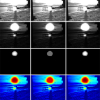Free Online Productivity Tools
i2Speak
i2Symbol
i2OCR
iTex2Img
iWeb2Print
iWeb2Shot
i2Type
iPdf2Split
iPdf2Merge
i2Bopomofo
i2Arabic
i2Style
i2Image
i2PDF
iLatex2Rtf
Sci2ools
78
Voted
CVPR
2010
IEEE
2010
IEEE
Sensor Saturation in Fourier Multiplexed Imaging
Optically multiplexed image acquisition techniques have become increasingly popular for encoding different exposures, color channels, light fields, and other properties of light onto two-dimensional image sensors. Recently, Fourier-based multiplexing and reconstruction approaches have been introduced in order to achieve a superior light transmission of the employed modulators and better signalto-noise characteristics of the reconstructed data. We show in this paper that Fourier-based reconstruction approaches suffer from severe artifacts in the case of sensor saturation, i.e. when the dynamic range of the scene exceeds the capabilities of the image sensor. We analyze the problem, and propose a novel combined optical light modulation and computational reconstruction method that not only suppresses such artifacts, but also allows us to recover a wider dynamic range than existing image-space multiplexing approaches.
Computer Vision | CVPR 2010 | Multiplexed Image Acquisition | Reconstruction Approaches | Reconstruction Approaches Suffer |
| Added | 06 Apr 2010 |
| Updated | 14 May 2010 |
| Type | Conference |
| Year | 2010 |
| Where | CVPR |
| Authors | Gordon Wetzstein, Ivo Ihrke, Wolfgang Heidrich |
Comments (0)

